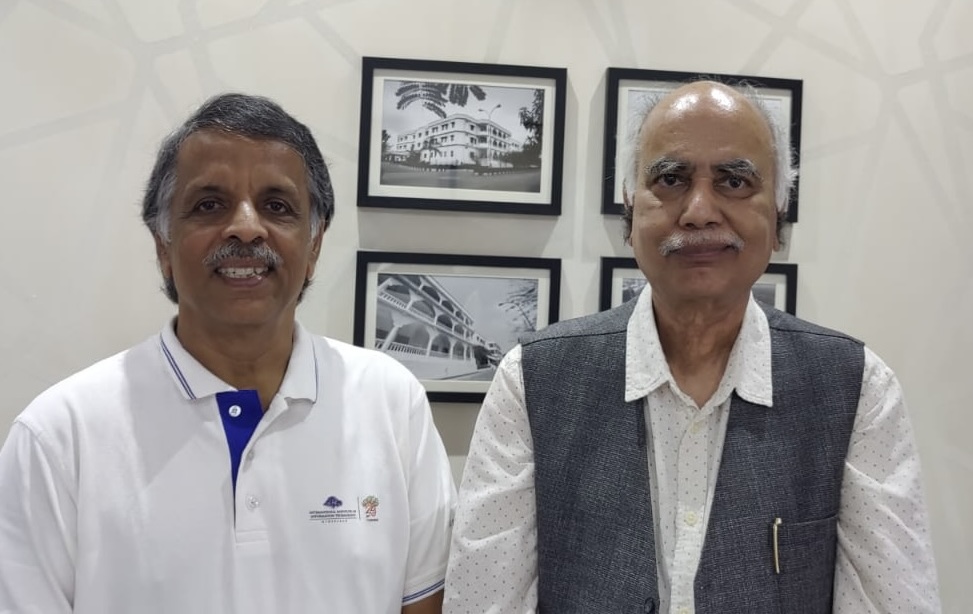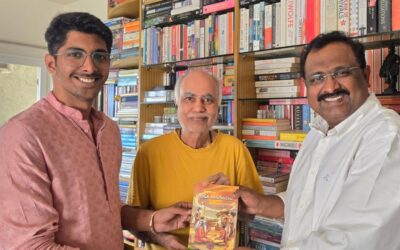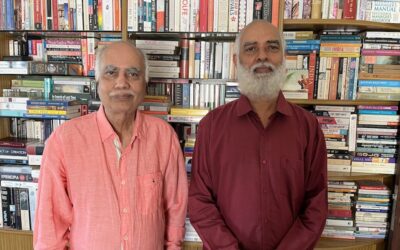
On Meeting a Sage Among Machines
Hyderabad was settled 500 years ago amid the vast expanse of stones and dust, a plateau beneath a hot sky. A part of it now bursts with high-rise glass towers, where the sun is mirrored when rising and setting. This new part is called Cyberabad, as though Hyderabad—rooted in time immemorial, bazaars and minarets—has reincarnated without dying. The great corporations—Microsoft, Google, Amazon, and Facebook—have come here with their vast encampments: shining fortresses of light. All of this, spun like a web around the institute, IIIT Hyderabad, where a handful of visionaries once sowed the first seeds.
There, among them, is P. J. Narayanan—PJN, as both his friends and students call him. From the quiet town of Alwaye to Kharagpur’s corridors, to Maryland’s cool libraries, to the laboratories of Bengaluru, his path was drawn, like a thread stitched carefully through decades. At CAIR (Centre for Artificial Intelligence and Robotics) in Bengaluru, he imagined pixels turning into moving scenes, reconstructed forms, and possible worlds inside a machine.
Among the pioneering faculty at the International Institute of Information Technology, Hyderabad (IIIT-H), PJN established the Centre for Visual Information Technology (CVIT). Patiently and steadily, he attracted brilliant students every year—the best among the brightest minds, restless with youth, hearts alight with questions—making it the largest of its kind in the country, breathing life into algorithms that see, imagine and remember. Thanks to him, if there is any other place in the world outside Silicon Valley in the US where AI technology truly comes to life, it is here.
In the realm of vision, machines learn to create depth from flat images—faces, streets and temples rising from two dimensions into three, as though a ghost of the real were summoned from the shadows. From the trembling of motion, structure emerges; from the flicker of pixels, entire worlds stand upright. In the realm of graphics, light lingers, refracts and bends its way across hidden surfaces; scenes ripple and shift like landscapes glimpsed in a dream.
Deep inside the humming chambers of the GPU (Graphics Processing Unit), armies of numbers surge and scatter—graphs shifting, strings unravelling and reweaving, patterns clustering like constellations and neural nets shimmering like webs spun overnight. What was once hidden now opens, clear and flowing, carrying the mark of PJN and his students.
When I learnt that he was stepping down from the directorship of the CVIT after completing two glorious terms, I found in him not even a shade of retirement, but the radiance of continuance. He spoke—gently, almost as though teaching a class again—of information technology as the arc of intelligence: how myth and metaphor evolved into mathematics; of Alan Turing’s sober challenge, the Dartmouth dream, and Deep Blue toppling Kasparov like a chess piece fallen in history’s great game.
And as PJN spoke, I witnessed his steady, unrelenting river of thought. From the all-knowing gods, demons and sages of old legends, through the rule-based logic, and now the neural networks that mimic the mind itself—what an incredible journey of intelligence! Now, it is in our pockets through smartphones, in the cars that drive us, and the Chatbots that answer whatever we ask. AI, PJN said, is not something at the door, knocking; it has slipped inside already, rearranged the furniture, set the clocks to its own time, and taken possession of the house.
“Should we be afraid?” I asked. For the air is thick with whispers—robots are replacing men, AI biases buried in data like stones that trip the unwary, inequalities sharpened, not softened, by automation’s hand. PJN chuckled—soft and unhurried, as though the worry were a child tugging at one’s sleeve. Fears, he said, cannot halt a sunrise. The birds who love the dark may complain, but the light comes—inevitable and indifferent. Our task is not to stop it—it cannot be stopped—but to shape it, so that it illuminates and does not blind.
It was here that our common roots in the Defence Research and Development Organisation (DRDO) surfaced. What about the great Public Sector Undertakings (PSUs) that have, for decades, formed the backbone of India’s industrial sector? Steel, coal, oil, power, railways—these were once temples of progress, but today, they stand on the threshold of a new revolution. How should they face this dawn of Industry 4.0, where machines learn, sensors whisper, and algorithms anticipate?
PJN’s words felt like counsel: PSUs must not retreat into nostalgia or fear. They must embrace indigenous technologies—crafted for Indian conditions, by Indian hands—and reskill their vast workforces so that machinists and welders become supervisors of robots, interpreters of data and partners of algorithms. The choice is simple: ride the tide of AI and robotics, or be left in their gushing wake.
I thought then of a steel plant in Durgapur, where predictive algorithms could halve the energy used in furnaces, making them not only more cost-effective but also cleaner. Of ONGC deploying drones that sweep across pipelines, spotting hairline cracks before disaster strikes. Of the Indian Railways’ running locomotives, whose sensors continuously report to central dashboards, predicting failures days in advance. Of BEML, supplying earthmoving machines across the global South.
These are not fantasies; they are glimmers already present. What they need is scale, commitment, and above all, faith in India’s own ingenuity. In that moment, I felt that PJN’s voice—measured, prophetic—was speaking not only to me, but also to managers of PSUs, to policymakers, to unions and to young apprentices just joining the shop floor.
When at last I rose to go, I placed my hand in his, and it was as if I touched not merely a man, but the distilled patience of years—the engineer who took a leap in frontline robotics, who became a teacher, the teacher who became a guide, and the guide who remains a sage. No clamour for power, no scent of self—only the quiet, luminous wish: that humanity, with all its frailties, might walk alongside its machines; not behind them, not beneath them, but together, into a future still unmade. The future does not have a blueprint; it builds upon what has been done. It has to be formed every day of our lives, with our own hands, minds and mistakes.
The Industry 4.0 of India must not be a job taker but a job creator. Over the years, we have become addicted to cheap imports. “Why develop when it is available?” is a defeatist mindset. While private companies, driven by profits, may do whatever it takes to make them rich, PSUs must do what makes the country strong and generates employment. I imagine a second innings of PJN, decisively tackling PSUs and making way for change as effortlessly as Moses parted the Red Sea.
MORE FROM THE BLOG
A Book Between Generations
It was a mild noon, neither summer nor winter, when Venkat Kumar Tangirala came to see me. The sun, hidden behind clouds that held back its heat, allowed only a soft light, as if words were holding their breath between two thoughts, unsure whether to be expressed or...
A Small Republic of Trust
It was a quiet forenoon when they arrived — father and son, two physicians bound by a lineage of service and an unspoken continuity between action and thought. The air outside was still, save for the occasional chirping of birds on my 14th-floor east-facing balcony....
From Wings to Light
My name found its place in the world through Wings of Fire, the autobiography of Dr A.P.J. Abdul Kalam, who invited me to walk beside him as co-author. When it was first published in December 1999 by Universities Press, the book did not immediately take flight. I...




Dear Sir, Thank you very much for your interesting blog on state-of-the-art technology. As rightly brought out, it is not knocking on your door; it has entered your house and has captured every corner of your house. As rightly brought out, AI is not an option for industry, research and academia; it is mandatory. The scale of application can vary, but it is and has to be part of every activity. We had this notion that computers would take away jobs during the early eighties when PCs were introduced in the workplace. Some bank and industry employees went on strike against computerisation. Now, each and every employee cannot do anything without a computer.
Likewise, AI is here to stay; we need to utilise it to achieve better efficiency and throughput. Industry will have to adapt or perish.
I am sure India will not only employ it but also master AI and demonstrate to the world how AI technology can be leveraged for the greater benefit of the industry and the public alike. May Prof. PJN continue to guide students, scientists, and industry with his rich experience for the greater good of society and Industry alike. May his cult grow. Thank you, sir.
Fascinating portrayal of the pioneering contributions made by the doyen of visual information technology, Prof Tiwariji!
His faith in indigenous technologies will go long way in invigorating the backbone of Indian industrial sector!!
As a junior from GB Pant University, Pantnagar, reading Sh. Arun Tiwari’s evocative blog feels like a bridge between generations of Indian engineers. His vivid portrayal of PJN not only highlights the quiet heroism in building institutions like CVIT but also resonates with my own aspirations in a field where innovation often stems from persistence amid resource constraints.
I admire how Arun Tiwari sir, weaves poetry into technical discourse—comparing AI’s rise to an inevitable sunrise or neural nets to shimmering webs—making complex ideas accessible and inspiring.
The discussion on AI’s societal impact strikes a chord; in an era of hype and anxiety, PJN’s balanced view—that we must shape rather than stop progress—reminds me of the ethical responsibilities we carry as technologists. For PSUs, Tiwari sir’s call to prioritise national strength and employment over short-term profits is a timely wake-up call, especially as India pushes for self-reliance. It makes me reflect on how my own career could contribute to this: perhaps by focusing on indigenous solutions that empower workers rather than displace them.
Thank you, sir. The blog instils optimism—AI isn’t a threat, but a partner —and figures like PJN and Tiwari sir show that with vision and humility, we can craft a future where technology serves humanity equitably. It’s a motivational read that urges action, leaving me eager to dive deeper into AI applications for India’s industrial backbone.
Thank you Sir for sharing your conversation with Prof. P.J Narayanan.
His role in building CVIT and shaping India’s AI ecosystem, especially at IIIT-H is truly inspiring.
Many times I have the same thought- “Should we be afraid?”
But the response, “Fears, he said, cannot halt a sunrise. The birds who love the dark may complain, but the light comes—inevitable and indifferent. Our task is not to stop it—it cannot be stopped—but to shape it, so that it illuminates and does not blind.” is so reassuring.
His calm, forward-looking approach to AI and automation is exactly the kind of leadership we need right now.
Prof Tiwari, Thank you for taking the time to employ your interaction with PJN as a base for such insightful reflection on what AI is and its role in the future. I could not have agreed more with PJN when he said: ‘PSUs must not retreat into nostalgia or fear. They must embrace indigenous technologies—crafted for Indian conditions, by Indian hands—and reskill their vast workforces so that machinists and welders become supervisors of robots, interpreters of data and partners of algorithms. The choice is simple: ride the tide of AI and robotics, or be left in their gushing wake.
Best wishes to him as he finds something useful with his life after such a successful tenure with CVIT. The choice is ours, world over!
Industry 4.0 and Indian PSUs (Public Sector Undertakings) is a crucial topic because PSUs still form the backbone of India’s energy, manufacturing, transport, and heavy industries. But they are also at risk of becoming obsolete if they fail to adapt to the ongoing technological transformation.
Large-scale digitisation, similar to what Infosys or Reliance Jio have done. Requires bold government funding. Focus on critical areas, such as predictive maintenance, robotics in hazardous tasks, and smart grids, rather than undertaking wholesale transformation. Collaborate with private sector startups and global technology leaders (Siemens, ABB, GE, TCS, Infosys, etc.) for quicker adoption.
Dear Sir,
Greetings!
Reading your account of Prof. P. J. Narayanan, I was reminded of a verse from the Bhagavad Gita: “Uddhared ātmanātmānaṁ” (BG 6.5) — one must elevate oneself by one’s own mind, not degrade oneself. In many ways, PJN’s journey and counsel reflect this teaching. He shows us that AI and Industry 4.0 are not forces to be feared, but opportunities to uplift—provided we embrace them with wisdom and responsibility. The call to reskill, to trust indigenous innovation, and to let machines walk with humanity rather than ahead of it, resonates deeply with India’s dharmic idea of balance. What struck me most was the reminder that sunrise cannot be stopped; our choice lies in how we prepare to receive its light. That is both a sage’s lesson and a roadmap for our future.
Warm Regards,
As a young IT engineer, Industry 4.0 feels less like a buzzword and more like a new universe of possibilities. Every day, I see how AI, IoT, cloud computing, and robotics are breaking the old silos between software and hardware. In manufacturing plants, my algorithms can predict when a motor will fail. In logistics, my code helps sensors talk to satellites to track supply chains in real time. In healthcare, the data models I work on can reduce patient wait times or even suggest treatments. This is not science fiction. It’s my everyday coding life—where “digital twins” simulate reality, where machine learning replaces guesswork, and where decisions that once took weeks are made in seconds.
Interesting blog.
The human touch in PJN’s (my apologies for to him, since I have never met or heard of him) is indeed profound.
May his tribe increase
Industry 4.0 refers to the integration of digital technologies—such as AI, IoT, robotics, 3D printing, cloud computing, AR/VR, and advanced analytics—into manufacturing and industrial processes. It promises automation, predictive efficiency, and real-time decision making. PSUs such as BHEL, SAIL, ONGC, NTPC, GAIL, Indian Railways, HAL, and DRDO-linked units are capital-intensive and large employers. Their competitiveness depends on whether they adopt Industry 4.0 tools.
Sir, congratulations on yet another very topical blog at a point when we see a fresh recognition of the capability & role of PSUs.
PSUs have, historically, been leaders in technology in the country and there capability has been clearly demonstrated in what the nation has achieved in the field of Space & Nuclear technologies.
Their manpower is also highly capable. However, today they are perceived to be slow and unproductive. However, given the right leadership and governance paradigms, there is little that these organisations cannot achieve. Nothing demonstrates their capability better than the response of these organisations in times of national calamities/ need.
Today is indeed an opportunity for the PSUs to reinvent themselves and come back to centre stage in the national context and again show there prowess in the technology field. The future business models will need to be collaborative with the PSU leading the technology development and with extensive outsourcing to MSMEs – to speed up innovation and reduce costs and at the same time reduce the technology & investment risk for the MSMEs. Creation of high tech ancillary clusters on the PSUs extensive land banks could be the core of such an effort – fuelling innovation and employment led growth and ensuring best of both the worlds.
There are learnings from the Chinese model where PSEs have played a major role in making the country an economic power house and a large number of Chinese SOEs figure in the Fortune Global 500 list..
The success achieved by us, in the Space & Nuclear technology fields, needs to be replicated to create multiple nodes for rapid, low cost, technological development in a uniquely Indian model
This was such an engaging read. I really liked how you connected Hyderabad’s transformation with PJN’s journey in building IIIT-H into a hub for AI research. The way you brought out his clarity on the future of AI and its role in reshaping PSUs felt very relevant and practical. What stayed with me most was the optimism in his outlook: that instead of fearing change, India can actually lead it by building its own solutions. A thoughtful piece that makes the reader reflect on both technology and responsibility.
Thank you, Arun ji, for yet another reflective blog.
Thank you, PJN Sir, for the camaraderie we share.
Reading about PJN’s steady work and his attitude toward AI made me pause. It’s rare to see a leader who isn’t driven by hype but by the deep question: How do we make technology serve humanity rather than overshadow it?
Nice to see you wrote about my good friend PJN. A beautifully woven tribute—both to a visionary like PJN and to the evolution of AI in India. The narrative blends history, technology, and personal legacy with poetic grace. Truly inspiring to see how one individual’s quiet persistence has shaped generations and sparked innovation that echoes globally.